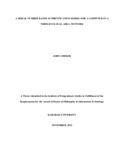A SERIAL NUMBER BASED AUTHENTICATION MODEL FOR A COMPUTER IN A WIRELESS LOCAL AREA NETWORK
Abstract
With today’s technological evolution, wireless networks have become very common for organizations, homes and public places due to the numerous benefits that come with them, as compared with wired networks. One of the biggest challenge though, is on how to control the ever increasing and dynamic nature of devices that use such kind of a network. Network access control security service uses identification, authentication, authorization and accounting services in that order, are used to provide such needed security controls. Machine based authentication methods are token, IP address and MAC address methods with their corresponding token, IP address and MAC address identifiers. A MAC address, a physical network address that is used as basis for this study, has a copy of its value in the system software that can be spoofed and altered rendering the address not unique, not secure and unreliable. On the contrary, a computer’s serial number is hard-coded in the system hardware only and therefore cannot be spoofed and altered making it unique, secure and reliable. The research, therefore, was aimed at designing a model that demonstrates how a computer’s serial number can be used for authenticating a computer in a wireless local area network. In order to achieve the research objective, the study examined the inbuilt access and use of a computer’s serial number prototype model as an alternative method of authenticating devices in a network. Design science research methodology that involved design and development, demonstration and model evaluation was employed. The Serial Number Based Authentication or SNAM model was therefore designed using state chart and flow chart diagrams based on dynamic programming, developed over evolutionary prototyping and test run on a static experimental design using Java Development Kit and MySQL platforms to demonstrate, as proof of concept, that a computer’s serial number can be used to authenticate a computer in a wireless local area network. The SNAM model first registered computers so that on execution, unregistered computers were denied network access while registered computers were allowed access to the network, based on the computer’s serial number. Allowed computer details are then displayed on an authentication interface to further either block a computer from the network if a need arises or allow the computer to continually use the network and its resources. From the test runs whose outcome were the binary values yes or no, it was found out that SNAM can actually allow or deny, enable or disable a computer in a network based on the computer’s serial number. The researcher therefore, recommends that the prototype be scaled up, then adopted as a network device authentication method

